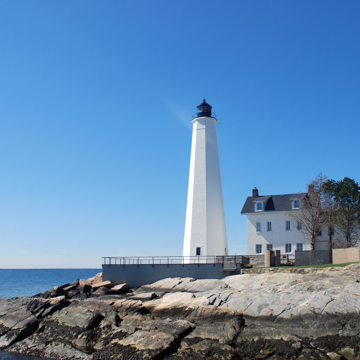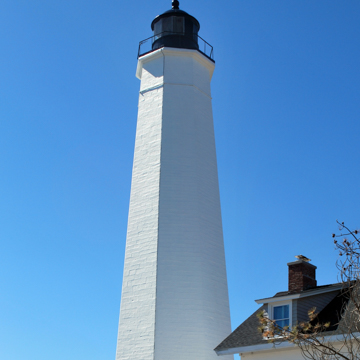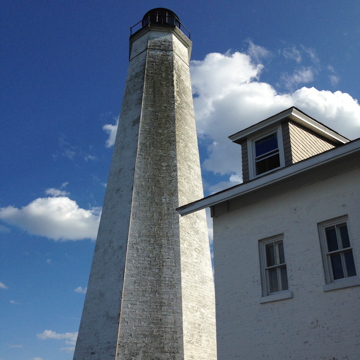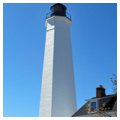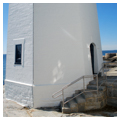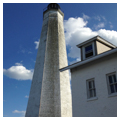You are here
New London Harbor Light
The New London Harbor Light station was established in 1761 as one of the first lighthouses to help mariners navigate the rocky shores of New England. New London’s deep natural harbor, rough waters, and eventual status as America’s third busiest whaling port in the early nineteenth century created the need for a local lighthouse. New London Harbor Light, which is today the oldest and tallest in Connecticut, was originally a beacon on the west side of the Thames River, marking the entrance to the Long Island Sound. Its history as a vitally important navigational aid, in addition to its unchanged design, has made the New London Harbor Light an important element of the Connecticut shoreline for more than two centuries.
As early as the 1730s, a light was established in New London as a military aid to warn against enemy fleets. By the late 1750s the need for an official beacon had grown and the colonial legislature of Connecticut hired a committee to raise funds and build the new station. In 1759, New London resident Nathaniel Shaw sold a portion of his land to the local government for the site of the new light and lottery tickets were offered to raise the £715 needed for construction. The 64-foot-tall, hammer-dressed stone tower with a wooden lantern was officially lit on November 7, 1761. The colony was responsible for raising funds for the lighthouse’s maintenance and operation, causing multiple tax increases on coastal shipping. When the Lighthouse Board was established in 1789, the lighthouse was ceded to the federal government. In 1791, President Washington signed a contract authorizing a quarterly $360 stipend to supply New London’s lamps with the spermaceti oil needed for continuous operation. By 1799, despite frequent repairs, the New London Lighthouse had become structurally deficient with a 10-foot crack in the stone descending from the lantern. Its low focal point also made the light nearly indistinguishable from the light emitted from local residences. In May 1800, Congress appropriated $15,700 for the construction of a new lighthouse and New London architect Abisha Woodward was hired to design the new structure.
Woodward’s New London Harbor Light opened in 1801 with a design that was a direct response to federal mandates. When Congress decided to accept responsibility for American lighthouses, it also instituted a short-lived style, known as “federal octagonal,” that was characterized by their distinctive forms and durable and long-lasting construction methods. In New London, responding to its coastal position and the strong winds at the mouth of the Thames River, Woodward designed an impressive 89-foot tapered octagonal tower with 19-inch-thick walls at the base. The foundation is made of granite, brownstone, and local stone and measures 25 feet and 8 inches in diameter. The tower is constructed of hammered-smooth brownstone laid in courses; its brick interior originally contained a spiral wooden staircase with regular landings. Six southwest-facing rectangular windows ascend one side of the structure with another singular window at ground level on the northeast side.
Woodward was also responsible for the Faulkner’s Island Light (1802). These are two of the nine surviving examples of federal octagon lighthouses in Connecticut. For the Lynde Point Light (1803), Five Mile Point Light (1805), and Black Rock Harbor Light (1808), Woodward employed a similar octagonal design, but specified wood construction instead of stone.
The New London Harbor Light was originally equipped with an oil-fueled cast-iron lantern that held one of the earliest eclipsers in the country, the first being installed at Cape Cod’s Highland Light in 1797. At the time, the eclipser was a regimented mechanism used to create a unique “characteristic,” or flashing pattern, for each lighthouse to distinguish one from another along the coastline.
After three decades of operation, maintenance was once again a problem in New London. By 1833, the lighthouse was in such a state of disrepair that contractor Charles H. Smith was hired to address multiple structural concerns and provide new fittings. Repair and refurbishment included a stone deck, an outer door with a lock, a lantern with iron railings, a wooden staircase, and a copper dome and vane. Smith also oversaw the repointing and whitewashing of the exterior. His staircase, the second wooden version, was later replaced with an iron spiral staircase with 119 steps, which remains in place to this day.
For security reasons, the lamp was extinguished during the War of 1812. In 1816, the tower was fitted with the Winslow Lewis patent lamp and reflectors, becoming one of the last in the United States to upgrade. During the 1833 renovation, this lamp was reinstalled inside the new dome, but it was quickly deemed insufficient. The final upgrade occurred in 1857 with the installation of a fourth order Fresnel lens that could illuminate a 315-degree field. The lens includes a central light within a larger encasement with curved glass members that reflect and magnify the light for greater strength. In 1909, the lamp’s power source was changed to an incandescent oil-vapor lamp; it was later automated with acetylene gas on July 20, 1912. Today, the 6,000 candlepower light is visible for 15 miles and alternates a white light and darkness at 3-second intervals. The historic Fresnel lens is one of the few still in operation in Connecticut.
Due to the weather patterns in the area, New London Harbor Light was the sight of multiple experiments with foghorn signals. The various types used on site included an early steam whistle, Daboll trumpets with a variety of engine upgrades, and a siren. Almost immediately, the siren met with disapproval from local residents who debated its necessity with the appreciative mariners. A quieter model was eventually substituted for the effective, but discordant, siren. It was ultimately removed from New London and placed offshore on the newly built New London Ledge Lighthouse in 1911.
Multiple structures were erected on the site to accommodate the needs of the light and the keepers. In 1818 a keeper’s dwelling built near the lighthouse replaced the original house. This was succeeded with a larger house in 1863, which was expanded in 1900 to accommodate the assistant keeper’s family. When the light was automated, the property was divided and the house came under private ownership. Records indicate that there was also a brick engine room, a fog-signal building, a barn, and a second fog-signal house, but all have since been demolished.
After the New London Harbor Light was automated in 1912, the property was sold to private owners and the United States Coast Guard took responsibility for maintaining the light. In 2009, the New London Maritime Society became the steward of New London Harbor Light. The Society renovated the lighthouse in 2014 with the help of Brand Energy and Infrastructure Services and a local Carpenters Union. Members of Painters Local 1122 assisted with cleaning, repointing, and repainting of the structure. Today, the newly restored lighthouse is in excellent structural condition and the light remains a vitally active mariners’ aid. The tower can be viewed from Pequot Avenue, but it is not currently open to the public.
References
Caukins, Frances Manwaring. History of New London, Connecticut from the First Survey of the Coast in 1612, to 1852. Hartford, CT: Press of Case, Tiffany and Co., 1852.
Decker, Robert Owen. The New London Merchants: The Rise and Decline of a Connecticut Port. New York: Garland Pub., 1986.
D’Entremont, Jeremy. “History of New London Harbor Lighthouse, New London, CT.” New England Lighthouses: A Virtual Guide. Accessed May 9, 2017. www.newenglandlighthouses.net.
D’Entremont, Jeremy. The Lighthouses of Connecticut. Beverly, MA: Commonwealth Editions, 2005.
Davidson, Donald W. Lighthouses of New England: From the Maritimes to Montauk. Secaucus, NJ: The Wellfleet Press, 1990.
Gleason, Sarah C. Kindly Lights: A History of the Lighthouses of Southern New England. Boston: Beacon Press, 1991.
Hamilton, Harlon. Lights and Legends: A Historical Guide to Lighthouses of Long Island Sound, Fishers Island Sound and Block Island Sound. Stamford, CT: Wescott Cove Publishing Company, 1987.
Hamilton, Robert A. “Crew from N.J. cutter is sprucing up the NL Harbor Light.” The Day121, no. 305 (2002): B1, B5.
Marcus, Jon. Lighthouses of New England: Your Guide to the Lighthouses of Maine, New Hampshire, Vermont, Massachusetts, Rhode Island, and Connecticut. Stillwater, MN: Voyageur Press, Inc., 2001.
“New London Harbor, CT.” Lighthouse Friends. Accessed March 25, 2015. www.lighthousefriends.com.
“New London Harbor ‘Pequot’ Light.” Custom House Maritime Museum. Accessed March 26, 2015. www.nlmaritimesociety.org.
Templeton, Dorothy B., “New London Harbor Light,” New London County, Connecticut. National Register of Historic Places Inventory–Nomination Form, 1990. National Park Service, U.S. Department of the Interior, Washington, D.C.
Rowlett, Russ. “Early Federal Octagonals, 1792–1817.” University of North Carolina at Chapel Hill. Accessed May 9, 2017. www.unc.edu.
Wheeler, Wayne C. “New London Lighthouse: America’s Fourth Light Station.” The Keeper’s Log(Winter 1996): 2-4.
Writing Credits
If SAH Archipedia has been useful to you, please consider supporting it.
SAH Archipedia tells the story of the United States through its buildings, landscapes, and cities. This freely available resource empowers the public with authoritative knowledge that deepens their understanding and appreciation of the built environment. But the Society of Architectural Historians, which created SAH Archipedia with University of Virginia Press, needs your support to maintain the high-caliber research, writing, photography, cartography, editing, design, and programming that make SAH Archipedia a trusted online resource available to all who value the history of place, heritage tourism, and learning.














